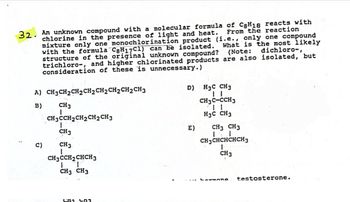
Organic Chemistry
9th Edition
ISBN: 9781305080485
Author: John E. McMurry
Publisher: Cengage Learning
expand_more
expand_more
format_list_bulleted
Question
PROBLEM 22) Can you explain this problem and solve it correctly, please!

Transcribed Image Text:32. An unknown compound with a molecular formula of C8H18 reacts with
chlorine in the presence of light and heat. From the reaction
mixture only one monochlorination product (i.e., only one compound
dichloro-,
with the formula C8H17C1) can be isolated. What is the most likely
structure of the original unknown compound?
trichloro-, and higher chlorinated products are also isolated, but
consideration of these is unnecessary.)
(Note:
A) CH3CH2CH2CH2 CH2 CH2CH2CH3
B)
CH3
1
CH3CCH2CH2CH2CH3
CH3
c)
CH3.
CH3CCH2CHCH3
1
..I.
│
CH3 CH3
CH₂ 433
D) H3C CH3
CH3C-CCH3
ודי
H3C CH3
E)
CH3 CH3
CH3CHCHCHCH3
1
CH3
harmone
testosterone.
Expert Solution
This question has been solved!
Explore an expertly crafted, step-by-step solution for a thorough understanding of key concepts.
Step by stepSolved in 2 steps with 1 images

Knowledge Booster
Similar questions
- Reaction of -pinene with borane followed by treatment of the resulting trialkylborane with alkaline hydrogen peroxide gives the following alcohol. Of the four possible cis,trans isomers, one is formed in over 85% yield. (a) Draw structural formulas for the four possible cis,trans isomers of the bicyclic alcohol. (b) Which is the structure of the isomer formed in 85% yield? How do you account for its formation? Create a model to help you make this prediction.arrow_forward3. Alkene Reactions - Give the structure of the major organic product formed in the reaction of 3,3-dimethyl-1-butene with each of the following: (a) hydrogen chloride (b) hydrogen bromide duct for the (c) dilute acid (H3O+) (d) BH3 in THF, followed by H2O2, OH- (e) Hg(OAc)2 in H2O, followed by NaBH4 (f) Br2 in CH2Cl2 (g) Br2 in H2O (h) mCPBA followed by H3O+ (i) O3, followed by Zn, H₂Oarrow_forwardFf.19.arrow_forward
- 6. a) The structural formulae of three isomers are shown below. - -CH2CH, CHO A OCH₂CCH3 B C-CH₂CH3 C With the aid of equations, describe the reactions of the isomers with i) Hydrazine, NH₂NH2 ii) lodine in an alkaline solution iii) Ammoniacal silver nitrate b) With the aid of equations, state the reagents and conditions required to prepare i) B from 1-phenylpropan-2-ol ii) C from benzenearrow_forwardThe natural product halomon could theoretically arise from another naturally occurring compound known as myrcene. To accomplish this, a biochemical process that could deliver the synthetic equivalent of BrCi to all three double bonds would be required. (Chem Comm. 2014, 50, 13725) (a) Using three molar equivalents of BrCL please provide a mechanism to account for the formation of the bracketed structure (you do not need to show stereochemistry in this mechanism) HB (3 equiv) myrcene balomon 8.61a Add curved arrow(s) to show the mechanism steps. Edit Drawing sitsarrow_forwardSelect the method that would be successful in producing the given product in good yield starting from benzene. Assume ortho and para isomers can be separated when applicable. (Note: The steps in a method are written in the order carried out) COOH ---- multisteps SO3H O (a)Br2/FeBr3,(b)CN, (c)H3O+/heat, (d)SO3/H2SO4 (a)Br2/FeBr3, (b)CN, (c)SO3/H2SO4, (d)H3O+/heat. (a)CH3Br/FeBr3, (b)KMnO4/H+.(c)SO3/H2SO4 O (a)SO3/H2SO4(b)CH3Br/FeBr3, (c)KMnO4/H+. (a)CH3Br/FeBr3, (b)SO3/H2SO4, (c) KMnO4/H+.arrow_forward
- Give detailed Solutionarrow_forwardf) Alkene X can be decomposed with hydrogen peroxide catalyzed by sodium tungstate to substance Q. This can be further degraded by iodoform reaction to substance R. Give the structures of substances Q and R. Xx S Na₂WO4 H₂O2 Q (C9H1603) 1: NaOH, 1₂ 2: H+ P₂O5 teplo - CHI3 R (C8H1404) P₂O5 teplo T g) The preparation of substance Q from substance X using hydrogen peroxide is a redox reaction. Identify the reductant and oxidant in this reaction, write the formal oxidation number to the atoms where it changes during the reaction and calculate the reaction. h) Substances Q and R undergo a reaction with phosphorous oxide under heating to form various products T and S. Determine the structure of substances T and S if you know their H NMR : 1H NMR (S): 2.2 (t, 2H); 1.8 (t, 2H); 1.3 (s, 6H). 1H NMR (T): 4.6 (d, 1H); 4.3 (d, 1H); 2.2 (t, 2H); 1.5 (t, 2H); 1.3 (s, 6H).arrow_forward.31 The cis and trans isomers of 2-butene give different cyclopropane products in the Simmons-Smith reaction. Show the structures of both, and explain the difference. cis-CH3CH=CHCH3 trans-CH₂CH=CHCH3 CH₂I₂, Zn(Cu) CH₂I2, Zn(Cu) ? ?arrow_forward
- Kj174.arrow_forwardPlease help me with the organic chemistry question below. Detailed explanations to aid in understanding are welcome.arrow_forward5.40. Give plausible products (or just one product) for each of the following reactions, or tell if no reaction is expected. (a) PDSO, + MgS > (b) (CH,),Hg + CaF, → 1. 1.arrow_forward
arrow_back_ios
SEE MORE QUESTIONS
arrow_forward_ios
Recommended textbooks for you

 Organic ChemistryChemistryISBN:9781305580350Author:William H. Brown, Brent L. Iverson, Eric Anslyn, Christopher S. FootePublisher:Cengage Learning
Organic ChemistryChemistryISBN:9781305580350Author:William H. Brown, Brent L. Iverson, Eric Anslyn, Christopher S. FootePublisher:Cengage Learning


Organic Chemistry
Chemistry
ISBN:9781305580350
Author:William H. Brown, Brent L. Iverson, Eric Anslyn, Christopher S. Foote
Publisher:Cengage Learning